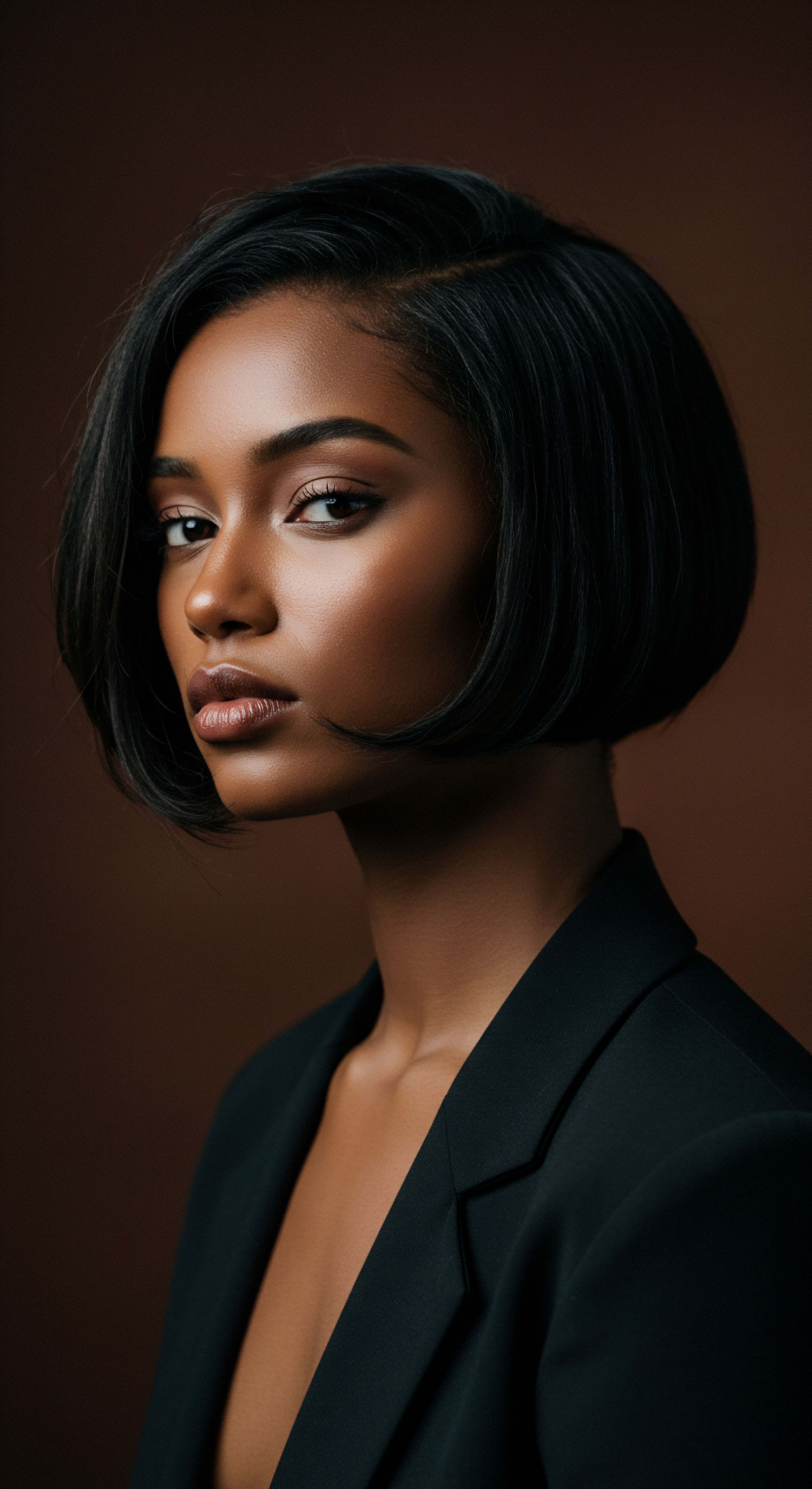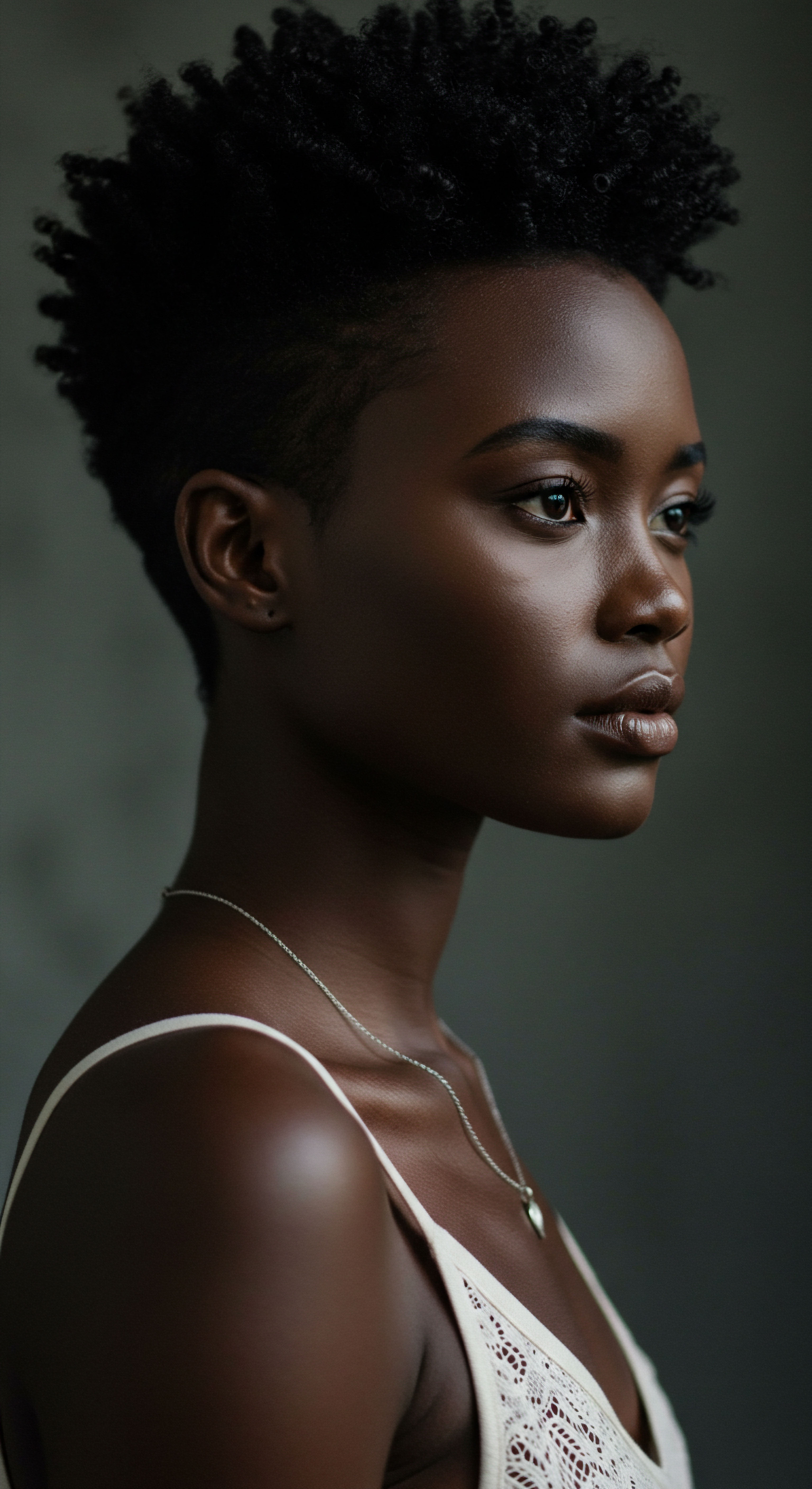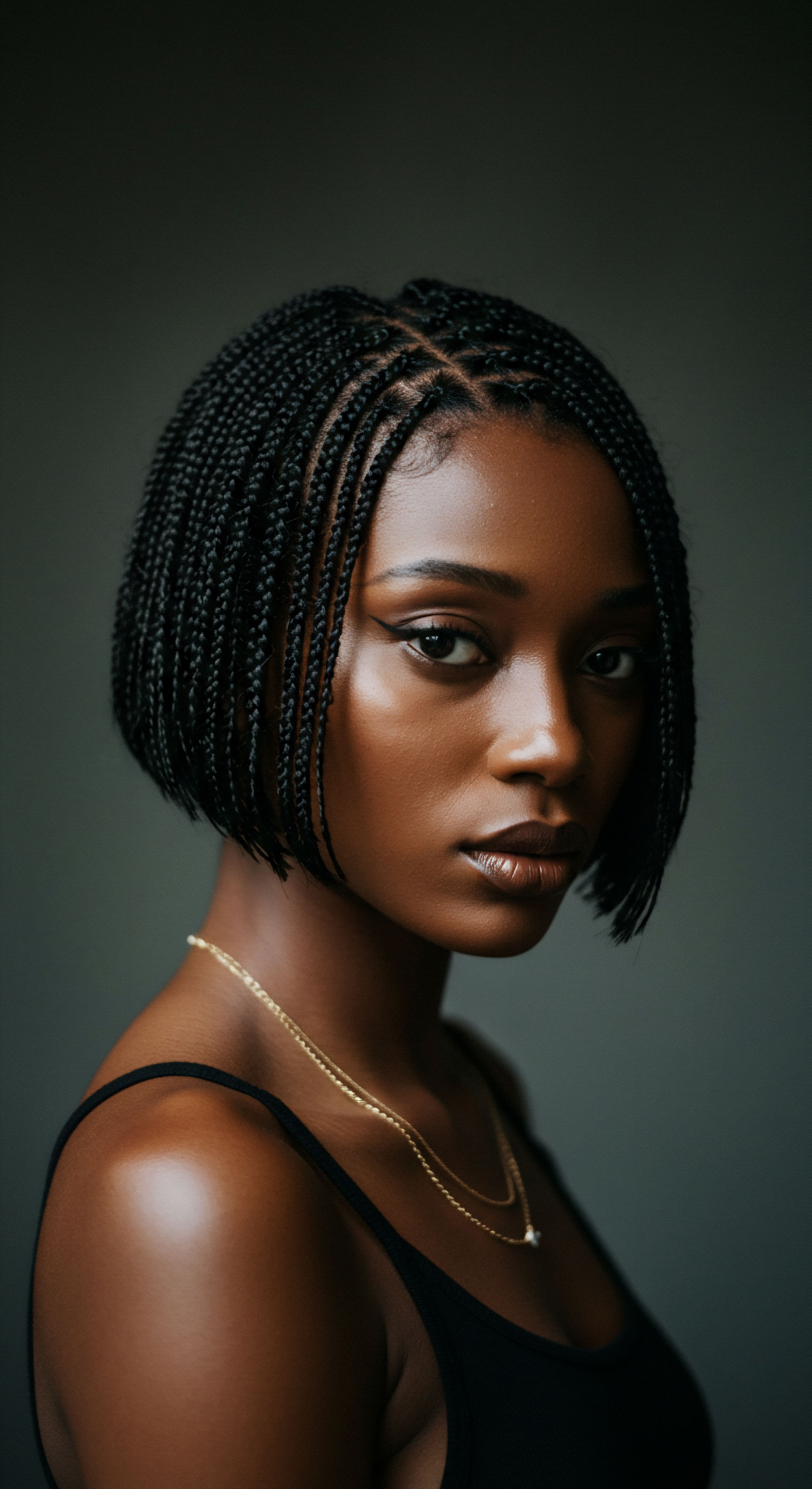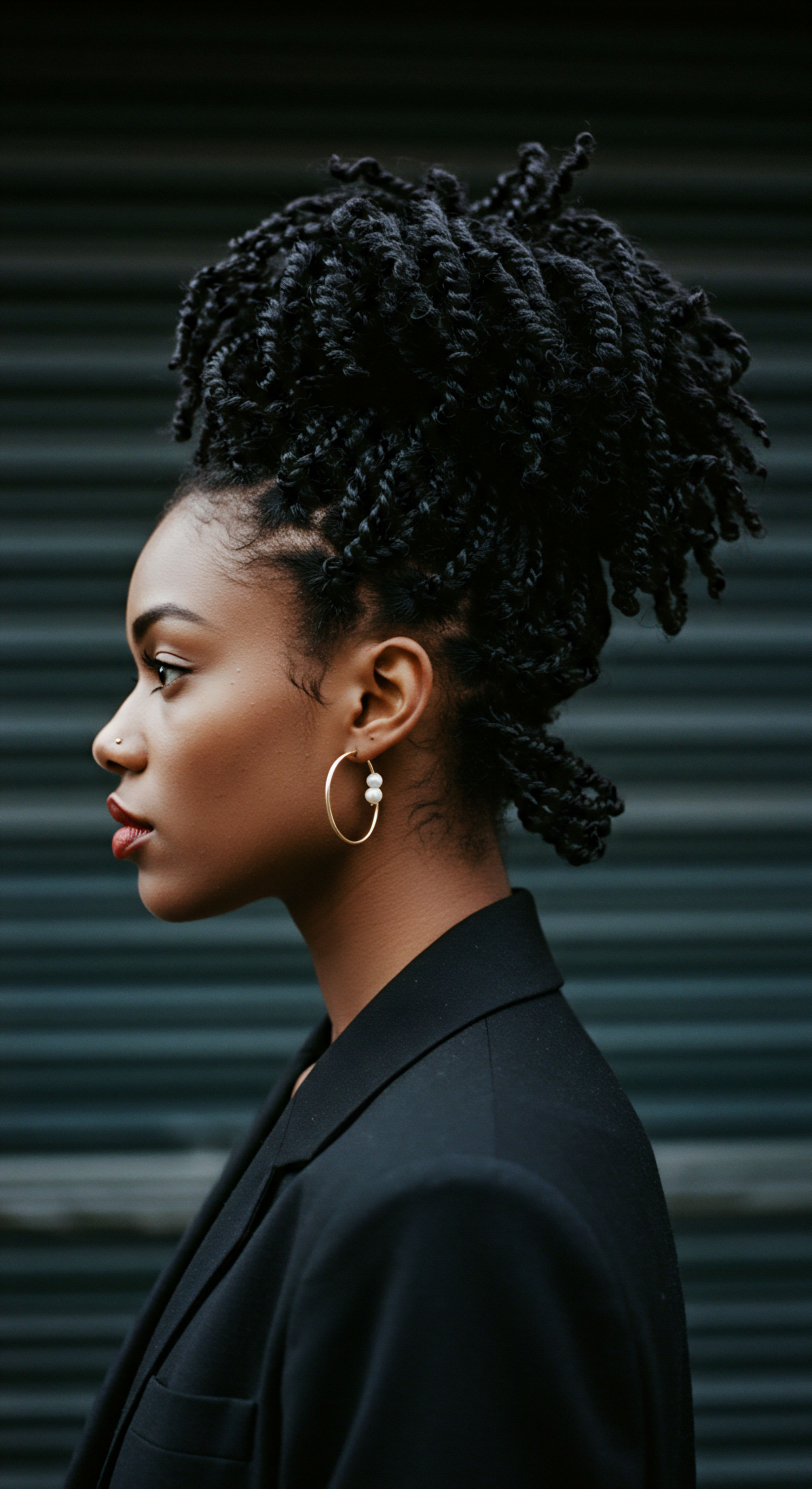
Roots
The whisper of natural oils on hair, a practice as old as time, calls to mind images of ancestral wisdom passed through generations, a quiet ritual beneath the canopy of ancient trees. It is a heritage of care, a gentle acknowledgment of the hair’s deep connection to the earth’s bounty. For those with textured strands, this relationship with natural oils holds particular significance, rooted in a history where such elixirs were not merely cosmetic additions, but essential guardians against environmental elements and the rigors of daily life. This exploration seeks to understand how these oils, seemingly simple, offer profound protection to hair, delving into their very composition and the ways they interact with each strand.

Hair’s Delicate Shield
At its core, hair possesses an inherent protective design. Each strand, a complex structure, is covered by an outer layer of overlapping cells, much like shingles on a roof. This outermost layer, the Cuticle, serves as the hair’s primary defense, safeguarding the inner cortex from damage.
When this cuticle lies flat and smooth, it reflects light, creating a lustrous appearance, and, more importantly, forms a barrier against moisture loss and external aggressors. However, chemical treatments, heat styling, and even environmental factors can lift or compromise these delicate scales, leaving the hair vulnerable.
Within the hair shaft, and particularly at its surface, are naturally occurring lipids. One prominent surface lipid is 18-Methyleicosanoic Acid (18-MEA), a unique fatty acid covalently bound to the cuticle proteins. This lipid contributes significantly to the hair’s hydrophobicity, meaning its ability to repel water.
When hair is healthy, this lipid layer helps maintain moisture balance and offers a degree of protection. However, routine shampooing, bleaching, and other harsh procedures can diminish this vital lipid, rendering the hair more susceptible to damage and water absorption.

The Architecture of Oils
Natural oils, extracted from plants, are not uniform substances. Their protective capabilities stem directly from their unique chemical architecture, primarily their fatty acid composition and molecular weight. These differences dictate how an oil interacts with the hair shaft, whether it merely coats the surface or penetrates deeper into the cortex.
The protective power of natural oils for hair stems from their varied molecular structures and fatty acid profiles, which determine how deeply they interact with hair fibers.
For instance, oils rich in smaller, straight-chain fatty acids, like Coconut Oil, possess a distinct advantage. Lauric acid, the principal fatty acid in coconut oil, has a low molecular weight and a linear conformation. This particular structure grants coconut oil a remarkable affinity for hair proteins, allowing it to penetrate the hair shaft more effectively than many other oils. This internal penetration is a key aspect of its protective action.
In contrast, oils with larger, bulkier fatty acid structures, or those primarily composed of triglycerides with less affinity for hair keratin, tend to remain on the surface, forming a coating. While this surface coating still offers protection, the depth of interaction differs significantly. Understanding these molecular nuances helps us appreciate the diverse ways natural oils shield hair.

What Components Allow Oils to Protect Hair?
The efficacy of natural oils in safeguarding hair is deeply tied to their chemical makeup. Beyond the fatty acids, many natural oils contain a wealth of other beneficial compounds.
- Antioxidants ❉ Many natural oils, such as argan oil and olive oil, contain antioxidants like Vitamin E and polyphenols. These compounds help combat oxidative stress, which can damage hair proteins and lipids, often caused by environmental factors like UV radiation.
- Vitamins and Minerals ❉ Oils can be rich in vitamins (like A and E) and minerals that contribute to overall hair health, indirectly bolstering its protective mechanisms by supporting its structural integrity.
- Anti-Inflammatory Compounds ❉ Some oils possess properties that can soothe scalp irritation, creating a healthier environment for hair growth. A healthy scalp is a foundational element for strong, protected hair.
The interplay of these components creates a multifaceted protective shield. The fatty acids directly interact with the hair structure, while other compounds address broader aspects of hair and scalp health, creating a more resilient environment for the strands.

Ritual
The gentle act of anointing hair with oils, a practice woven into the fabric of daily life for generations, extends beyond simple conditioning; it is a ritual of preservation. It speaks to a quiet wisdom, passed down through touch and observation, about how certain natural elixirs can stand guard over our strands. This section explores the practical application of these ancient remedies, moving from the foundational understanding of oils to their active roles in shielding hair from the wear and tear of existence. It delves into the how, the why, and the subtle alchemy that occurs when natural oils meet hair.

How Oils Create a Physical Barrier
One of the most immediate and tangible ways natural oils protect hair is by forming a physical barrier on the hair’s surface. This external coating serves as a shield against a multitude of environmental and mechanical stressors.
When applied, oils coat the hair shaft, creating a hydrophobic film. This film repels water, which is particularly beneficial for textured hair types prone to excessive swelling when exposed to humidity. Hair swelling and subsequent drying can lead to significant stress on the hair fiber, contributing to frizz and breakage. By limiting water absorption, oils help maintain the hair’s structural integrity and reduce hygral fatigue.
Consider the impact of styling tools and daily manipulation. Combing, brushing, and styling can cause friction, leading to cuticle damage and eventual breakage. Oils act as lubricants, reducing this friction and allowing styling tools to glide more smoothly over the hair. This mechanical protection minimizes stress on the cuticle, preserving its flattened state and overall health.
| Protective Mechanism Hydrophobic Coating |
| Description Oils create a water-repelling film on the hair surface. |
| Key Benefit Reduces water absorption, preventing frizz and hygral fatigue. |
| Protective Mechanism Lubrication |
| Description Oils reduce friction during styling and manipulation. |
| Key Benefit Minimizes mechanical damage, breakage, and cuticle lifting. |
| Protective Mechanism Environmental Shield |
| Description Forms a barrier against pollutants and UV radiation. |
| Key Benefit Lessens oxidative damage and degradation of hair proteins. |
| Protective Mechanism These external actions provide immediate and visible protection for hair. |

Penetration and Internal Reinforcement
Beyond surface-level defense, certain natural oils offer a deeper layer of protection by penetrating the hair shaft. This internal action is particularly significant for fortifying the hair from within.
The ability of an oil to penetrate the hair fiber is largely dependent on its molecular size and chemical affinity for hair proteins. Coconut Oil stands out in this regard. Its primary fatty acid, lauric acid, has a low molecular weight and a straight chain, allowing it to slip through the cuticle and into the cortex. Once inside, it is believed to bind to hair proteins, effectively reducing protein loss.
Coconut oil’s unique molecular structure allows it to penetrate hair fibers, actively reducing protein loss and strengthening strands from within.
A study published in the Journal of Cosmetic Science observed that coconut oil significantly reduced protein loss for both undamaged and damaged hair when used as a pre-wash and post-wash grooming product. This contrasts sharply with mineral oil and sunflower oil, which, while good sealants, did not offer the same protein-preserving benefits due to their inability to penetrate the hair shaft as effectively. This capacity to reduce protein loss is a profound protective mechanism, as protein is the very building block of hair.

Does Oil Penetration Help Hair Maintain Its Strength?
Indeed, the penetration of certain oils plays a substantial role in maintaining hair strength and resilience. When hair loses protein, its structural integrity is compromised, leading to weakness, brittleness, and increased susceptibility to breakage. By mitigating this protein loss, oils like coconut oil help preserve the hair’s inherent strength.
This internal fortification is especially important for hair that has undergone chemical treatments, such as coloring or relaxing, which can strip away hair lipids and proteins. Applying penetrating oils before or after such processes can help to offset some of the damage, acting as a restorative shield. The oil occupies internal spaces within the hair, potentially preventing the entry of damaging agents and supporting the hair’s internal lipid layers.

Protecting Hair from Environmental Stressors
Our hair faces a daily onslaught from the environment, from harsh sunlight to urban pollution. Natural oils offer a measure of defense against these invisible aggressors.
Many oils contain natural antioxidants. For instance, Olive Oil has been studied for its photoprotective qualities, partly due to the presence of hydroxytyrosol, a polyphenol that can combat reactive oxygen species (ROS) induced by UV light. Similarly, Argan Oil, rich in Vitamin E and other antioxidants, helps protect against oxidative damage caused by UV radiation and environmental pollutants.
The physical barrier formed by oils also offers direct protection against particulate pollutants, preventing them from adhering directly to the hair shaft and causing degradation. This dual action—both physical shielding and biochemical neutralization of damaging free radicals—underscores the comprehensive protective role of natural oils.

Relay
Beyond the visible sheen and the softened touch, the interaction between natural oils and hair extends into a sophisticated interplay of chemistry, biology, and even cultural heritage. It is a story of subtle molecular dialogues and the enduring wisdom of generations. This section takes a deeper dive into the less obvious, yet profoundly significant, ways natural oils shield hair, examining their influence on the hair’s lipid architecture, their role in maintaining scalp health, and the broader context of their traditional usage. It is an invitation to consider the intricate dance of protection that unfolds beneath the surface.

The Hair’s Lipid Layer and Oil’s Affinity
The hair fiber is not merely a collection of proteins; it possesses a complex lipid profile that is critical for its health and integrity. The outermost layer of the cuticle is covered by a covalently bound lipid, 18-Methyleicosanoic Acid (18-MEA), which is responsible for the hair’s natural hydrophobicity and smooth feel. When this layer is compromised, such as through chemical treatments like bleaching, hair becomes more hydrophilic and prone to damage.
Natural oils, particularly those with specific fatty acid compositions, can interact with this lipid layer in nuanced ways. While some oils form a superficial coating, others, like coconut oil, can truly penetrate the hair shaft, reaching the cortex. This is attributed to the oil’s affinity for hair proteins and its small molecular size.
Coconut oil’s lauric acid, a medium-chain fatty acid, is particularly effective in this regard. This penetration allows the oil to fill the gaps created by damage, reinforcing the hair’s internal structure and helping to reduce protein loss.
This internal reinforcement is a critical, yet often overlooked, aspect of protection. It suggests that certain oils do not merely mask damage but actively contribute to the hair’s resilience at a molecular level. The concept of oils “filling the gaps” in damaged hair, as suggested by some research, speaks to a restorative action that goes beyond simple conditioning.

How Do Oils Prevent Protein Loss in Hair?
The mechanism by which certain oils, notably coconut oil, prevent protein loss from hair is a subject of ongoing scientific interest. The prevailing theory points to the unique structure of lauric acid.
- Direct Penetration and Binding ❉ Lauric acid’s small size and linear shape allow it to penetrate the hair shaft deeply. Once inside, its strong affinity for hair proteins, particularly keratin, enables it to bind to these proteins.
- Reduced Swelling ❉ By penetrating the cortex, coconut oil can reduce the swelling of the hair fiber caused by water absorption. Reduced swelling means less stress on the hair structure during washing and drying cycles, thereby minimizing protein leaching.
- Filling Porous Cavities ❉ In damaged hair, there are often porous areas or gaps within the hair shaft. Coconut oil can enter these spaces, effectively “plugging” them. This physical occupation of space helps to prevent further protein efflux during washing.
This protective action is particularly evident in pre-wash applications, where the oil is applied before shampooing. By saturating the hair with oil prior to washing, the amount of water absorbed by the hair during the wash cycle is reduced, leading to less swelling and, consequently, less protein loss. This phenomenon has been well-documented in studies comparing coconut oil to other oils.

The Scalp’s Role in Hair Protection
The health of the scalp is intrinsically linked to the health and protection of the hair. A compromised scalp environment can lead to weaker hair fibers and increased susceptibility to damage. Natural oils play a significant, albeit indirect, protective role by contributing to scalp health.
Some oils possess antimicrobial and anti-inflammatory properties. For instance, Jojoba Oil, which closely resembles the natural sebum produced by the human scalp, can help regulate sebum production. Studies indicate that jojoba oil can reduce sebum secretion, contributing to a balanced scalp environment. This regulation is beneficial because both excessive oiliness and dryness can compromise scalp health, potentially leading to conditions that hinder hair growth and protection.
Other oils, like Tea Tree Oil, are known for their antifungal and antibacterial qualities, which can address scalp conditions such as dandruff. By maintaining a healthy scalp microbiome and reducing irritation, these oils indirectly bolster the hair’s protective capabilities, as healthy hair typically grows from a healthy scalp.
Maintaining a balanced scalp microbiome through natural oils is crucial for fostering an optimal environment for healthy hair growth and intrinsic protection.

The Controversial Case of Mineral Oil and Water Absorption
While natural oils are celebrated for their protective qualities, a specific point of contention arises when comparing them to mineral oil, particularly concerning water absorption. It is often asserted that natural oils are superior due to their ability to penetrate the hair shaft, which mineral oil does not. However, research presents a more nuanced perspective on the role of surface coating in preventing water uptake.
A study conducted by Keis et al. in 2007 investigated the effect of oil films on moisture vapor uptake by human hair. The findings revealed that while coconut oil penetrates the hair fiber and mineral oil does not, both oils demonstrated an equivalent reduction in water sorption. This suggests that the oil remaining in the cuticle layer, forming an external coating, is primarily responsible for the decrease in water absorption, rather than the oil that penetrates the cortex.
This observation challenges the simple notion that penetration is the sole determinant of an oil’s protective effect against water absorption. It underscores the importance of the external barrier function, even for oils that do not deeply penetrate. For textured hair, where managing moisture fluctuations is paramount, this surface-level hydrophobicity, whether from a penetrating oil or a non-penetrating one, remains a significant protective mechanism.

The Cultural and Historical Context of Hair Oiling
The protective qualities of natural oils are not merely modern scientific discoveries; they are deeply embedded in the cultural practices of various communities, particularly those with textured hair. For centuries, hair oiling has been a ritual of care, beauty, and preservation across African, Asian, and other indigenous cultures.
In traditional Indian Ayurvedic medicine, for instance, hair oiling with coconut oil has been a daily ritual for over 4,000 years, believed to benefit both hair and general well-being. Similarly, castor oil has been used in ancient Egypt since 4000 BC for maintaining hair growth and strength. The Moroccan Berber people have long been recognized for their healthy hair and skin, with Argan Oil being a presumed factor.
These long-standing traditions, passed down through generations, often precede modern scientific explanations. They represent an accumulated practical wisdom regarding the protective benefits of oils against harsh climates, styling practices, and the natural characteristics of textured hair. The continuous application of oils provided a consistent barrier against sun, wind, and the friction of daily life, keeping strands supple and resilient. This historical context grounds the scientific findings in a lived reality, showing that the efficacy of natural oils has been observed and relied upon for millennia.

Reflection
As the light softens on our understanding of natural oils and their profound connection to hair, particularly textured hair, a quiet appreciation settles. We have traversed the intricate pathways from the molecular architecture of a single oil droplet to the grand sweep of cultural practices, witnessing how these humble gifts from the earth offer a sanctuary for our strands. The science speaks of fatty acids binding to proteins, of cuticles sealed against the world’s harshness, and of antioxidants standing guard against invisible threats.
Yet, beyond the chemical reactions and the biological responses, there lies a deeper truth ❉ the simple, enduring power of thoughtful care. It is a reminder that protection is not always a grand, complex intervention, but often a consistent, gentle presence, a whisper of natural wisdom that guides us toward celebrating the inherent beauty and strength of every curl and coil.

References
- Rele, V. R. & Mohile, R. B. (2003). Hair Oils ❉ Indigenous Knowledge Revisited. Journal of Cosmetic Science, 54(5), 175-192.
- Kaushik, V. et al. (2019). Penetration study of oils and its formulations into the human hair using confocal microscopy. Journal of Cosmetic Dermatology, 18(6), 1947-1954.
- Hywel, C. (2025). Hair Oils Unlocked. Barnes & Noble Press.
- Dattani Book Agency. (n.d.). Cosmetics & Toiletries Books.
- Leite Junior, A. C. & Baioco, C. C. (2024). Essential Oils for Hair Health ❉ A Critical Mini-Review of the Current Evidence and Future Directions. Brazilian Journal of Health Aromatherapy and Essential Oil, 1(1), bjhae3.
- Keis, K. et al. (2007). Effect of oil films on moisture vapor uptake by human hair. Journal of Cosmetic Science, 58(5), 523-532.
- Rele, V. R. & Mohile, R. B. (2003). Effect of mineral oil, sunflower oil, and coconut oil on prevention of hair damage. Journal of Cosmetic Science, 54(2), 175-192.
- Sade, D. (2018). The Aromatherapy Beauty Guide ❉ Using the Science of Carrier & Essential Oils to Create Natural Personal Care Products. Robert Rose Inc.
- Berton, H. (2016). The Essential Guide to Natural Skin Care. North Atlantic Books.
- Green, M. & Keville, K. (2008). Aromatherapy ❉ A Complete Guide to the Healing Art. Random House Digital Inc.
- El Boustani, S. & El Boustani, M. (2022). The Importance of Argan Oil in Medicine and Cosmetology. Cosmetics, 9(6), 119.
- Consensus AI. (2024). Essential Oils for Your Hair. Consensus ❉ AI Search Engine for Research.
- Verywell Health. (2025). 14 Essential Oils that Promote Faster Hair Growth.
- Amazon.com. (n.d.). Hair Treatment Oils ❉ Books.
- Fernandes, S. S. et al. (2024). Impact of Hair Damage on the Penetration Profile of Coconut, Avocado, and Argan Oils into Caucasian Hair Fibers. Cosmetics, 11(2), 58.
- Khan, N. et al. (2024). Phytochemicals in hair care ❉ A review of natural ingredients and their applications. GSC Biological and Pharmaceutical Sciences, 26(01), 247-258.
- Healthline. (2023). Essential Oils for Hair Health and Growth.
- Sharma, S. et al. (2021). Development and Evaluation of Herbal Hair Serum ❉ A traditional way to Improve Hair Quality. Journal of Drug Delivery and Therapeutics, 11(4), 10-16.
- Medical News Today. (2023). Rosemary oil and hair growth ❉ Research, effectiveness, and tips.
- Healthline. (2018). Shea Butter for Hair ❉ Raw, Hair Growth, and Natural Hair.
- African Fair Trade Society. (2023). Does Shea Butter Straighten Hair?
- Lv, X. et al. (2024). The Role of Linoleic Acid in Skin and Hair Health ❉ A Review. Cosmetics, 11(1), 16.
- Phong, C. et al. (2022). Coconut, Castor, and Argan Oil for Hair in Skin of Color Patients ❉ A Systematic Review. Journal of Drugs in Dermatology, 21(7), 751-757.
- Verma, N. & Singh, J. (2024). Coconut oil – Nature’s own emollient. Indian Journal of Dermatology, Venereology, and Leprology, 90(6), 1157-1160.
- OilCocos. (2024). Coconut Oil’s Influence on Hair Protein Structure.
- Wimpole Clinic. (2025). Jojoba Oil For Hair ❉ Benefits And Uses for Excellent Results.
- K18 PRO. (2024). The Science of Heat Protection by Oil.
- ResearchGate. (n.d.). Confirmation of the coating that changes the physical properties of hair.
- Ahmad, A. (2014). Jojoba oil as an organic, shelf stable standard oil-phase base for cosmetic industry. International Journal of Current Pharmaceutical Research, 6(3), 3-5.
- Scarring Alopecia Foundation. (2024). Hair Oils ❉ Do Coconut, Castor, and Argan Oils Really Work?
- Nutrafol. (n.d.). New Topicals to Support a Healthy Scalp While Preserving the Microbiome ❉ A Report of Clinical and in Vitro Studies.
- Reddit. (2023). Good hair oils for penetration and sealing? ❉ r/HaircareScience.
- Sharma, S. et al. (2021). Assessment of Nutraceutical Potential of Herbs for Promoting Hair Growth ❉ Formulation Considerations of Herbal Hair Oil. The Open Dermatology Journal, 15(1).
- Jojoba Desert. (2022). Jojoba Desert Releases Results of Jojoba Oil on Sebum Reduction, Anti-Acne.
- Cosmetics Business. (2022). JD Jojoba Oil ❉ Reducing Sebum with Anti-Acne Potential.
- Healthline. (2019). Coconut Oil for Hair Growth ❉ Research, Efficacy, and More.
- Argan Oil for Hair Growth. (n.d.). Protection of the hair.
- Lestari, W. P. et al. (2022). Hair Growth Promotion of Argan Oil (Argania Spinosa Skeels) Nanoemulsion Hair Tonic Preparation With Mice (Mus Musculus). KnE Medicine, 2(3), 598-603.
- Butter by Q. (2024). Is Shea Butter Good for High Porosity Hair? What’s Best?
- Wuli Hair Care. (2025). The Abundant Benefits of Shea Butter for Curly Hair.
- Pantene. (n.d.). The Benefits of Shea Butter for Natural Hair.